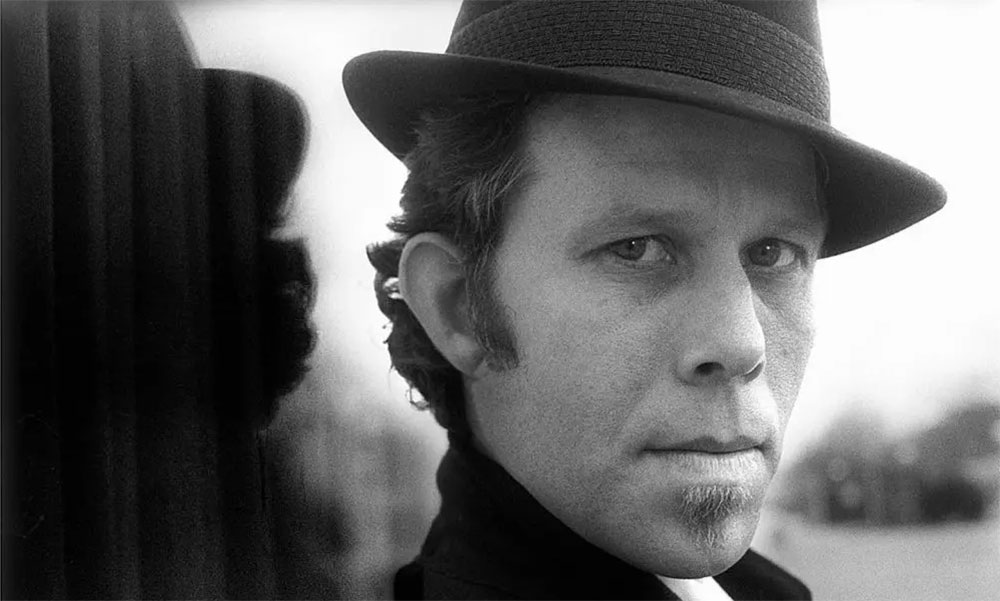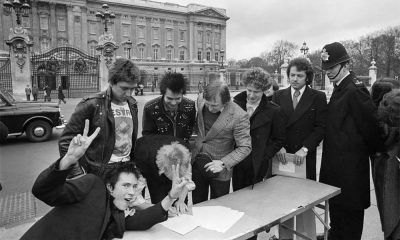News
Tom Waits’ Classic Mid-Period Island Records Studio Catalog Set For Vinyl, CD Reissue


Personally overseen by Tom Waits and Kathleen Brennan, Waits spectacular middle-period albums–released on Island Records between 1983 and 1993—have been newly remastered from the original tapes and will be reissued on vinyl and CD this fall via Island/UMe.
Waits’ transformative creative breakthrough, Swordfishtrombones (1983), its sprawling and superb sequel, Rain Dogs (1985), and the trilogy-completing, tragi-comic stage musical, Franks Wild Years (1987), will kick off the series September 1, 40 years to the day that Swordfishtrombones was released into the wild, ushering in a new and critically acclaimed musical era for Waits and his longtime songwriting and production partner, Brennan.
The epic song-cycle, Bone Machine (1992) and the under-appreciated Waits (with Robert Wilson and William S. Burroughs) musical fable, The Black Rider (1993), will follow October 6. September, incredibly, marks the 40th anniversary of Swordfishtrombones, and the 30th of The Black Rider.
Ahead of their physical releases, all of the albums are available to stream today featuring the newly remastered audio, allowing fans to hear how these landmark recordings now sound better and more vivid than ever.
In addition to streaming and download, each album will be released on CD and in two vinyl options: 180-gram black vinyl and a limited edition color variant that will be available exclusively via Waits’ official website and UDiscover Music. Swordfishtrombones will be pressed on canary, Rain Dogs on opaque sky blue, Franks Wild Years on opaque gold, The Black Rider on opaque apple and Bone Machine on translucent milky vinyl.
All albums were mastered by Chris Bellman at Bernie Grundman Mastering under the guidance of Waits’ longtime audio engineer, Karl Derfler. Swordfishtrombones was sourced from the original EQ’ed ½” production master tapes while Rain Dogs, Franks Wild Years, Bone Machine and The Black Rider were sourced from the original ½” flat master tapes. Bellman meticulously transferred the tapes and then remastered the audio in high resolution 192 kHz/24-bit. The lacquers for all titles were cut by Alex Abrash at AA Mastering.
The new vinyl editions will come with specially made labels featuring photos of Waits from each era in addition to artwork and packaging that has been painstakingly recreated to replicate the original LPs, which have been out of print since their initial release. Surprisingly, The Black Rider and Bone Machine were never released on vinyl outside of Europe and will be making their vinyl debut in most of the world.
These critically acclaimed works are a monument to an artist’s ability to break through into new creative territory.
Waits went from ‘70’s-era “bluesy, boozy” wordsmith and melodist with seven albums behind him to sound sculptor, miner of the subconscious, abstract orchestrator, sonic cubist—while retaining his innate lyricism, melodic invention, humanity. A rough analogy: Picasso switching from exquisite literal depictions to pouring his brain and id out onto canvas. Waits was still painting, in other words, but the frames were made of blood and bone and feathers and old carburetors.
Working with experimental composer Francis Thumm, and taking inspiration from the music of found-object composer Harry Partch—plus Waits’ friend, Captain Beefheart—the renowned singer-songwriter reinvented his sound, album by album.
As he put it in a 1983 interview: “I tried to listen to the noise in my head and invent some junkyard orchestral deviation—a mutant apparatus to drive this noise into a wreck collection.”
Not that Waits’ early albums were devoid of artistic progression. There were the piano-based jazz-folk ballads of his remarkable debut, Closing Time (just remastered for its 50th anniversary), the beat/jazzy/smokey flavor of Nighthawks at the Diner, the piano-bass-sax-drums sagas of the landmark, Small Change, the experimental tone poem, “Burma Shave,” on Foreign Affairs, the grit and grunge of the stripped-down Heart Attack And Vine… All this would stand alone as a great body of work if the man had never written another note.
But with Swordfishtrombones and the albums that followed, Waits shifted gears, or rather, deliberately ground them. New York Times music critic Stephen Holden wrote: “Miles away from the (music) he used in the ‘70s to evoke the wrong side of the tracks, his evolved style is an abrasive, lurching honky-tonk that at its most adventurous suggests a fusion of Captain Beefheart’s Dadaist extensions of the delta blues with the Kurt Weill of ‘Threepenny Opera.’”
Swordfishtrombones (the title a winking tribute to Beefheart’s magnum opus, Trout Mask Replica) was a Waits-arranged pastiche, a variety of atmospheres from different sound planets. There is the warped, marching-army-ants music of “Underground,” an impressionist chant about people living below cities, but there was also the poignancy of the spare piano ballad, “Soldier’s Things,” the good bar yarn, “Frank’s Wild Years” (pre-figuring the musical of the same name), the tender, minimalist paean to Waits’ wife and muse, Kathleen, “Johnsburg, Illinois,” and the raggedy anthem to neighborhood chaos, “In the Neighborhood.”
Considered the middle of a de facto trilogy with Swordfishtrombones and Franks Wild Years, Rain Dogs came next—written in a Lower Manhattan basement and recorded at RCA in New York City. Waits and Brennan moved there in 1984, when Brennan suggested it might be good for creativity. She was right. A 53-minute, 19-track monster, Rain Dogs was a kind of mutant, late 20th century musical “Canterbury Tales” with a shape-shifting band.
There were banjos and marimbas and bowed saw and parade drum and howling horns (and Keith Richards and Marc Ribot) on this rollicking, rough-hewn opus—and Waits was using his voice in increasingly weird-and-wild ways (prompting Esquire to drolly declare it “America’s most distinctive.”) The songs were stories, sagas, laments, breakdowns, character studies, comedies, cabaret numbers, an aching thing that The Rolling Stones should have covered, “Hang Down Your Head,” and the moving anthem, “Downtown Train,” which was later covered by Patti Smith and Rod Stewart. Those were both co-written by Brennan who also helped pen “Gun Street Girl” and “Jockey Full Of Bourbon.”
Waits coined the term, “rain dog,” a reference to dogs who lose their way when touchstone scents are washed away in storms. Among the lost dogs on the album: gruff, wandering merchant marines (“Singapore”), an accordion player in a slaughterhouse (“Cemetery Polka”), a “jockey full of bourbon” (also the song title), an abandoned, withdrawn woman (“Time”), a “gun street girl,” the old drunks and hustlers of Union Square, and even Waits, himself: Aboard a shipwreck train / Give my umbrella to the Rain Dogs / For I am a Rain Dog, too. . .
“Most of the people in the stories,” Waits said in 1985, “made a turn here, a turn there; went through a door and somebody picked ’em up and they all went down the road. Before they knew it, they were lost. ‘Singapore’ is like that. Richard Burton in Taiwan.”
Franks Wild Years, the album, is based on the Waits musical of the same name, performed with Waits in the lead role by Chicago’s Steppenwolf Theater (directed by Gary Sinise) during the summer of 1986. Recorded mostly in Hollywood, the idea for Franks came from the Swordfishtrombones spoken-word piece in which a used-furniture salesman (Frank), suffocating in middle-class existence with a “spent piece of used jet trash” wife and her blind Chihuahua, Carlos, burns down his house. With smoking rubble in his rear-view mirror, he hits the freeway with the parting quip, “Never could stand that dog.”
Waits and Brennan developed this into Frank as an accordion player escaping the mythical town of Rainville for a calamitous but noble journey to Las Vegas and New York, in search of stardom. In the end, broke and bewildered, Frank—“a guy who stepped in every bucket on the road,” as Waits put it—dreams his way back to Rainville, while freezing on a park bench in St. Louis. Until he suddenly wakes up and finds himself home in the saloon where it all started. Brennan christened it “un operachi romantico.” and New Musical Express ranked the work the number five album of 1987.
“It closes a chapter, I guess,” Waits said when Franks was released. “Somehow the three albums seem to go together. Frank took off in Swordfishtrombones, had a good time in Rain Dogs and he’s all grown up in Franks Wild Years.”
The Black Rider, Waits’ next project after Franks, is an extraordinary melding of the art of three extraordinary persons: Waits, experimental director Robert Wilson, the late legendary writer, William S. Burroughs. (Note: The Black Rider music was written in 1988-89, recorded in ’89 and ’93, and the Waits album was released in ’93.)
Based on the 19th century German/Bohemian folk tale of a young clerk who makes a deal with the devil (“Der Freischütz,” famously an 1821 opera by Carl Maria Von Weber), The Black Rider is Waits at his most surreal, playful, musically gnarled. Think: 1929 Berlin cabaret meets “Frankenstein” if F.W. Murnau movie sets could sing. This two-and-a-half-hour musical fable (Wilson calls it an opera) premiered March 31, 1990, at the Thalia Theater in Hamburg, Germany, and is still part of standard repertory in Europe. Waits did not sing or appear in the production, which featured a cast of eleven (Marianne Faithful played “Pegleg”—the devil—in a 2004 Wilson world-touring revival), and has been extensively staged in the U.S., Canada, Australia.
Bone Machine was, to borrow a cliché, a smash—released in 1992 to universal critical acclaim, followed by a Grammy for “Best Alternative Music Album.” Waits co-wrote half of the album’s sixteen works with Brennan, and special guests included David Hidalgo, Les Claypool (bass), and Keith Richards (who co-wrote “That Feel.”)
Recorded in Prairie Sun Studios in Cotati, Calif.—described by Waits as “just a cement floor and a hot water heater”—the album was a radical redesign of Waits’ soundscapes and writing technique. The songs weren’t composed—they sound more forged, hammered, chiseled, bent. Waits and Brennan seem to have conjured the record out of dirt, cracked pavement, broken tree branches, and bird song. Their move to a rural area of Northern California heavily influenced the ideas and music of the record.
Some of the press: Musician: “a raw-boned masterpiece.” New York Times: “Nothing short of breathtaking.” Rolling Stone: “Rich with spiritual longing.” Chicago Tribune: “bursts with color and emotion.” Billboard: “One of the finest records of the year.” Washington Post: “His finest album.” Melody Maker: “Ragged glory.” New Musical Express: “Scary, mournful, morbid and easily one of Tom’s best.” Select: “Tom Waits’ supreme achievement to date, his ‘One Hundred Years of Solitude.’”
Waits called the songs on Bone Machine “little movies for the ears.” He sometimes wrote them entirely from a percussion pattern, which he played on an array of largely homemade instruments. One, the “conundrum,” was essentially a large iron crucifix with crowbars and found metal objects hanging off of it. As Tom explained at the time, “I have a lot of very strong rhythmic impulses, but this is not my world. I just pick something up and I hit it, and if I like the sound, it goes on. Sometimes my idiot approach serves the music.”
Mortality is a recurrent theme, from “Dirt In The Ground” (“We’re all gonna be. . .”) to “All Stripped Down,” “The Ocean Doesn’t Want Me” (a tale of contemplated suicide), “Jesus Gonna Be Here,” the rambunctious paean to childhood, “I Don’t Wanna Grow Up,” and certainly the broken-hearted, confessional classic Waits ballad, “Whistle Down The Wind,” which was beautifully covered by Joan Baez on her titular 2018 album. Waits explained at the time: “Yeah, ultimately, it will be a subject that you deal with. Some deal with it earlier than others, but it will be dealt with. Eventually we’ll all have to line up and kiss the devil’s arse.”
The press wrote that this was Waits’ first album in five years, but in point of fact, he had been extremely busy since Franks Wild Years with many projects, large and small—from writing and half-recording The Black Rider to the evocative, mostly-instrumental album soundtrack to Jim Jarmusch’s film, “Night on Earth” (1992, Island Records). Bone Machine further established Tom as one of the most inventive and prolific artists of our time, and presaged even more daring music to come.

-
Paul McCartney And Wings To Release Historic Live Album ‘One Hand Clapping’
-
Elton John Earns Multi-Platinum Plaque For ‘Diamonds,’ Shares ‘Step Into Christmas’ EP
-
Jon Batiste Announces ‘Uneasy Tour: Purifying The Airwaves For The People’
-
Best Political Punk Songs: 20 Essential Anti-Establishment Tirades





